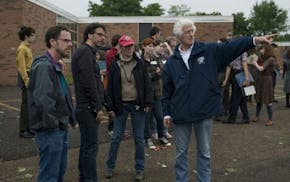"I'm not high-maintenance," Diana Kennedy said with a gleam in her eye. "I've got high standards. There's a difference."
Kennedy, 87, was at a momentary standstill in the kitchen at Cooks of Crocus Hill in St. Paul, where staff members from the cooking school were prepping food for her presentation later that evening.
"The meat is low-fat. I'm unhappy about that," she said of the meat filling that was intended for the stuffed jalapeño. Then she headed over to the stock pot and took a sip of the broth. "This is not as strong as it should be." Kennedy reached for a sauté pan and cooked some chicken livers before adding water to simmer the meat. "This will make it stronger."
"Do you have sea salt? Not that awful kosher salt," she asked Karl Benson, owner of Cooks, who was helping with the prep.
"Where are the wooden spoons?" she asked. "I don't like cooking with plastic."
"You're doing that all wrong," she said to the staff, exasperated, her arms in the air, her head shaking.
Yes, indeed, Diana Kennedy has high standards. "It takes us about six months to recover from her visits," said Benson with a smile.
Kennedy, one of the last of the cooking legends, was on a one-month tour promoting her new book. The opinionated, some might say demanding, author had recently fired her agent and organized the tour on her own, often staying with friends as she promoted what can only be called her masterpiece.
"Oaxaca al Gusto: An Infinite Gastronomy," (University of Texas Press, 437 pages, $50), first published in Mexico and 11 years in the making, is a stunner. Kennedy has gathered the recipes and stories of those living in the state of Oaxaca, a region of both significant cultural and topographic diversity. Not only is the text fascinating, but there are rich photographs throughout, and hers are particularly noteworthy among the many featured. (She insists on photo credits on each page.)
Kennedy arrived in Mexico in 1957 and was drawn to the culture. Her work as a researcher and teacher has brought her international accolades; she has written eight cookbooks.
This volume was prompted by a request from the governor of Oaxaca, though that connection came to a close. She notes in her introduction to the book that a later collaboration with a publisher ended "when it was apparent that the style and content of the book were being severely compromised."
When asked if she had to make accommodations for a U.S. audience (because it was first published in Mexico,), she was blunt: "I have not adapted for anyone. I'm not catering to anyone. This is a grown-up book."
That means that not all ingredients are available to U.S. cooks -- such as those for the Wasp-Nest Sauce. Nor are all the chiles available, a subject near to her heart.
"We should be helping our neighbors. In supermarkets, there are the most exotic ingredients possible. Why not those from Mexico? Let's get them and use them. It is important to growers in isolated areas [such as Oaxaca]. It helps them preserve their environment."
Kennedy had been shopping earlier with Benson at El Burrito Mercado in West St. Paul, a spot she said had the nation's best Mexican supplies -- even better than Los Angeles, she noted.
"Oh, my God, you are slow," she groaned to the staff. "We are very behind. Hurry, hurry."
She was near the end of her tour and anxious to get back to Mexico, where she would soon be a judge in a small mountain village for a cooking contest on pasties, what are usually called Cornish pasties here, a dough with a meat filling that miners ate for lunch. In Oaxaco the pasties are made with ground pork and chiles, just one more practial adaptation of food.
The burners were turned off in the kitchen; the Cooks staff was done with the prep. Benson booted up the computer for her PowerPoint slide show later.
"I take food seriously. It's got to turn out delicious," Kennedy said. "It's very important."
Lee Svitak Dean • 612-673-1749
Spring's hot gift book features gorgeous found-nature photos

Jane Smiley hits again with 'Lucky' but what the what is that ending?

Biography details what 'Rulebreaker' Barbara Walters did to get to the top
